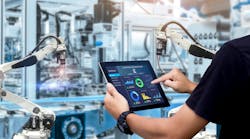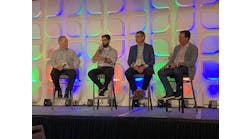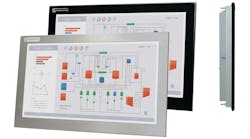The Industrial Internet of Things (IIoT) has already begun to change business models and manufacturing operations, right down to the way people interact with machinery.
Dr. Irene J. Petrick, market innovation director, and Dr. Faith McCreary, principal engineer, Internet-of-Things Group at Intel conducted a six-month study of workers to uncover techniques to help organizations transition to the digital factory.
“I get to look at the future,” said Petrick, who also sat on an expert panel at NIWeek in Austin, Texas, in May. “We’re seeing what we call the gray tsunami—an incredible amount of brainpower and expertise retiring. That’s one of the trends that will change the landscape of technology.”
That trend is built around batch-size-of-one manufacturing. “In discrete, it’s the expectation of customization,” explained Petrick. “That’s a completely different type of production than what we’ve been seeing. We’re going to go to high-mix, low-volume. Our factories have to be much more agile. Our material handling has to be more agile.”
Computing at the edge will continue to expand and enable the type of flexible engineering capacity that will make batch-size-of-one possible. “I can put sensors into machines and have transparency,” said Petrick. “I can act on these signals if I have the right kind of processing and analytics. Where does the compute need to happen? We’re seeing a different type of architecture. I have to understand how the point solution plays out. In brownfield factories, these are some serious challenges.”
One of the more interesting predictions Petrick made related to a change from manufacturers’ purchase of capital equipment to purchasing machine productivity. “We talk about Industry 4.0, and we talk about the new business models it will generate,” she explained. Because of monitoring capabilities, machine builders will finally start to move toward production-as-a-service, in which they bill for uptime. “That will accelerate the analytics,” said Petrick. “How do I know how agile I need to be as a company? Material handling is a great example of how we need to change the types of production.”
Key questions arise regarding how to handle the data spilling from these sensors. Do you work at the edge? Do you work in an on-premise server cloud? What about dynamic compute from edge to cloud and back?
“We’re seeing a trend toward more generalizable compute,” explained Petrick. “The nature of the compute is going to change. And we’re going to be able to dial it up and dial it back, as needed. Ultimately we have to have security at the machine level, at the chip level and at the software level. We’ve done a lot of work talking to manufacturers about the security because they say if we can’t tell them about the security, then don’t talk about anything else.”
Petrick and McCreary will talk specifically about the results of their survey at the 4th Annual Smart Industry event, September 24-26 in Rosemont, Illinois. Discrete manufacturing is about to change dramatically. Get to Smart Industry to learn all of the new developments. Whether you’ve embraced them yet or not, batch-size-of-one and production-as-a-service are coming. And manufacturing business models will never be the same.






